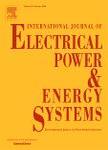版权所有:内蒙古大学图书馆 技术提供:维普资讯• 智图
内蒙古自治区呼和浩特市赛罕区大学西街235号 邮编: 010021

作者机构:Shandong Univ Minist Educ Key Lab Power Syst Intelligent Dispatch & Control 17923 Jingshi Rd Jinan 250061 Shandong Peoples R China Univ Cambridge Inst Mfg 17 Charles Babbage Rd Cambridge CB3 0FS England Tech Univ Denmark DTU Dept Elect Engn Ctr Elect Power & Energy CEE DK-2800 Lyngby Denmark
出 版 物:《INTERNATIONAL JOURNAL OF ELECTRICAL POWER & ENERGY SYSTEMS》 (国际电力与能源系统杂志)
年 卷 期:2019年第107卷
页 面:363-378页
核心收录:
基 金:National Key Research and Development Program of China [2018YFB0904004] Natural Science Youth Foundation of Shandong province [ZR2018QEE005] Young Scholars Program of Shandong University
主 题:DFIG ES Fuzzy logic controller Inertia Frequency regulation Wind speed
摘 要:In a power system with a high penetration rate of wind power generation, the rotor speed of a doubly fed induction generator (DFIG) is decoupled from the system frequency;thus, DFIG has no short-term frequency response capability, and the system frequency stability is significantly affected compared to that in a power grid with more conventional synchronous generators. For this reason, a novel fuzzy theory-based coordinated control strategy is presented for improving the short-term frequency response capability of a DFIG-energy storage (ES) system. Firstly, to make the short-term frequency response capability of the DFIG-ES system adaptive for various wind speed conditions, based on the analysis of the DFIG operation characteristics under different wind speeds, four wind speed zones are classified, and accordingly different operation strategies are designed for each wind speed zone. Afterwards, two kinds of fuzzy logic controllers (FLCs) are designed and deployed in the DFIG-ES control system. Specifically, according to the fuzzy logic rules, frequency deviation and DFIG operation state are treated as input parameters, and correspondingly the power support from the combined system and the participation coefficient of the DFIG for short-term frequency support are determined. Moreover, the realization of the presented control strategy is detailedly described. Finally, case studies have been conducted to demonstrate the performance of the proposed control strategy via the comparison between different control strategies, and the simulation results illustrate that the coordinated control strategy can effectively improve the short-term frequency response capability of the DFIG-ES system under various wind speeds.